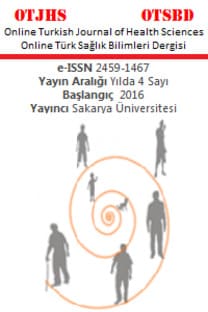Diyabetik Nöropatisi Olan Kişilerde Monosit/HDL Kolesterol Oranı ile Kardiyovasküler Risk Arasındaki İlişki
Diyabetik nöropati, kardiyovasküler risk, monosit/HDL-K
The Relationship Between Monocyte / HDL-Cholesterol Ratio and Cardiovascular Risk in Diabetic Neuropathia
Diabetic neuropathy, cardiovascular risk, monocyte/HDL-C,
___
- 1. Dokken BB. The Pathophysiology of Cardiovascular Disease and Diabetes: Beyond Blood Pressure and Lipids. Diabetes Spectrum. 2008;21(3):160-165. doi: 10.2337/diaspect.21.3.160.
- 2. Oto A. Diabet ve Koroner Arter Hastalığı: Gelişen Dünyanın Korkunç İkilisi. Türkiye Kardiovasküler Tıp Elektronik Dergisi. 2007 Nov. Avaible from: http://www. Turkkardiyovaskulertipe-dergisi.com Last Access: 16th May 2011.
- 3. Bansal V, Kalita J, Misra UK. Diabetic neuropathy. Postgrad Med J. 2006;82:95–100.
- 4. Barter PJ, Nicholls S, Rye KA, et al. Antiinflammatory properties of HDL. Circ Res. 2004;95:764–772.
- 5. Negi G, Kumar A, Joshi RP, et al. Oxidative stress and Nrf2 in the pathophysiology of diabetic neuropathy: old perspective with a new angle. Biochem and Biophys Res Commun. 2011;408:1–5.
- 6. Kızıltunç E, Alsancak Y, Sezenöz B, et al. Relationship Between Monocyte/High-Density Lipoprotein Cholesterol Ratio and Angiographic Severity and Extent of Coronary Artery Disease. Koşuyolu Heart J. 2017;20(1):30-35.
- 7. Charnogursky GA, Emanuele NV, Emanuele MA. Neurological complications of diabetes. Curr Neurol Neurosci Rep. 2014;14:457:1-16. 8. Johnstone MT, Nesto R. Diabetes mellitus and heart disease. In: Pickup JC, Williams G, editors. Joslin's Diabetes Mellitus. 14th ed. Philadelphia: Lippincott Williams and Wilkins; 2005:975- 998.
- 9. Expert Panel on Detection, Evaluation, and Treatment of High Blood Cholesterol in Adults. Executive Summary of The Third Report of The National Cholesterol Education Program (NCEP) Expert Panel on Detection, Evaluation, And Treatment of High Blood Cholesterol In Adults (Adult Treatment Panel III). JAMA. 2001; 285: 2486-2497.
- 10. UK Prospective Diabetes Study (UKPDS) Group. Intensive blood-glucose control with sulfonylureas or insulin compared with conventional treatment and risk of comlications in patients with type 2 diabetes. Lancet 1998;352:854-65.
- 11. Katulanda P, Ranasinghe P, Jayawardena R, et al. The prevalence, patterns and predictors of diabetic peripheral neuropathy in a developing country. Diabetol Metab Syndr. 2012;4:21:1–8. doi: 10.1186/1758-5996-4-21.
- 12. Perez-Matos MC, Morales-Alvarez MC, Mendivil CO. Lipids: a suitable therapeutic target in diabetic neuropathy. J Diabetes Res. 2017:6943851:1–9. doi: 10.1155/2017/6943851.
- 13. Krauss RM. Lipids and lipoproteins in patients with type 2 diabetes. Diabetes Care. 2004;27:1496–1504.
- 14. Çomoğlu S, Yardımcı S, Okçu Z. The alterations in plasma lipid profile of diabetic polyneuropathic patients. T Klin J Med Sci. 2001;21:345–348.
- 15. Isomaa B, Henricsson M, Almgren P, et al. The metabolic syndrome influences the risk of chronic complications in patients with Type II diabetes. Diabetologia. 2001;44:1148–1154.
- 16. Obrosova IG, Ilnytska O, Lyzogubov VV, et al. High-fat diet induced neuropathy of pre-diabetes and obesity: effects of “healthy” diet and aldose reductase inhibition. Diabetes. 2007;56:2598–2608.
- 17. Murphy AJ, Woollard KJ, Hoang A, et al. High density lipoprotein reduces the human monocyte inflammatory response. Arterioscler Thromb Vasc Biol. 2008;28:2071–2077.
- 18. Garcia C, Feve B, Ferré P, et al. Diabetes and inflammation: fundamental aspects and clinical implications. Diabetes Metab. 2010;36:327–338.
- 19. Skundric DS, Lisak RP. Role of neuropoietic cytokines in development and progression of diabetic polyneuropathy: from glucose metabolism to neurodegeneration. Exp Diabesity Res. 2003;4:303–312.
- 20. Lim AK, Tesch GH. Inflammation in diabetic nephropathy. Mediators Inflamm. 2012:146154:1-12.
- 21. Blüher M, Unger R, Rassoul F, et al. Relation between glycaemic control, hyperinsulinaemia and plasma concentrations of soluble adhesion molecules in patients with impaired glucose tolerance or Type II diabetes. Diabetologia. 2002;45:210–216.
- 22. Hilgendorf I, Swirski FK, Robbins CS. Monocyte fate in atherosclerosis. Arterioscler Thromb Vasc Biol. 2015;35:272–279.
- 23. Nandy D, Janardhanan R, Mukhopadhyay D, et al. Effect of hyperglycemia on human monocyte activation. J Investig Med. 2011;59:661–667.
- 24. Negi G, Kumar A, Joshi RP, et al. Oxidative stress and Nrf2 in the pathophysiology of diabetic neuropathy: old perspective with a new angle. Biochem and Biophys Res Commun. 2011;408:1–5.
- 25. Canpolat U, Çetin EH, Cetin S, et al. Association of monocyte-to-HDL cholesterol ratio with slow coronary flow is linked to systemic inflammation. Clin Appl Thromb Hemost. 2016;22:476–482.
- 26. Kundi H, Kiziltunc E, Cetin M, et al. Association of monocyte/HDL-C ratio with SYNTAX scores in patients with stable coronary artery disease. Herz. 2016;41:523–529.
- 27. Karatas A, Turkmen E, Erdem E, Dugeroglu H, Kaya Y.Monocyte to high-density lipoprotein cholesterol ratio in patients with diabetes mellitus and diabetic nephropathy. Biomark Med. 2018;12(9):953-959.
- 28. Aydin E, Ates I, Arikan MF, Yilmaz N, Dede F.The ratio of monocyte frequency to HDL cholesterol level as a predictor of asymptomatic organ damage in patients with primary hypertension. Hypertens Research. 2017;40(8):758-764.
- 29. Cetin MS, Cetin EH, Kalender E, et al. Monocyte to HDL Cholesterol Ratio Predicts Coronary Artery Disease Severity and Future Major Cardiovascular Adverse Events in Acute Coronary Syndrome. Heart Lung Circ. 2016;25(11):1077-1086.
- 30. Vural G.,Gümüşyayla Ş., Monocyte-to-high density lipoprotein ratio is associated with a decreased compound muscle action potential amplitude in patients with diabetic axonal polyneuropathy. Medicine (Baltimore). 2018;97(42).
- ISSN: 2459-1467
- Yayın Aralığı: Yılda 4 Sayı
- Başlangıç: 2016
- Yayıncı: Oğuz KARABAY
Akılcı Antibiyotik Kullanımına Uyumda Aile Hekimlerinin Rolü
Ahmet Rıza ŞAHİN, Çiğdem TEKER, Pelin MUTLU AĞAOĞLU, Selçuk NAZİK, Selma ATEŞ
Huzurevinde Yaşayan Yaşlıların Beslenme Durumları ve Günlük Yaşam Aktivitelerinin Belirlenmesi
Emine EKİCİ, Merve YETİM ÇOLAK, Ezgi Hasret KOZAN
Akut Yetmezlikte Karaciğer Nakli; Tek Merkez Deneyimi
Gokhan ERTUGRUL, Tumay YANARAL
Çiğdem ÜNAL KANTEKIN, Müge ÇAKIRCA, Ferda YAMAN, Ayşe Yeşim GÖÇMEN
Apendiks Tümörlerinin İnsidansı, Tedavisi ve Sağ Kalım: Retrospektif Bir Çalışma
Servet KOCAÖZ, Emin GEMCIOĞLU, Abdurrezzak YILMAZ, Aydan KILIÇARSLAN, Ömer PARLAK
Halime Hanım PENÇE, Hanife Şerife AKTAŞ
Hartmann Kolostomi Kapatılması Esnasında Gelişen Mesane Perforasyonu; Bir Olgu Sunumu
Evde Bakım Birimince Takip Edilen Hastaların Bakımlarından Sorumlu Kişilerde Depresyon
Serkan TOKER, Arzu AYRALER, Rahime ÖZGÜR
Testis Torsiyonu ile Ortalama Trombosit Hacminin İlişkisi
Almanya'da Yaşayan Türk Göçmenlerin Ruh Sağlığının Değerlendirilmesi
Murat Eren OZEN, Gulumser PELTEK, Mehmet Hamdi ORUM, Aysun KALENDEROGLU, Salih SELEK
